The State of Human Capital and Innovativeness of Polish Voivodships in 2004–2018
Abstract
:1. Introduction
2. Literature Review
3. Materials and Methods
- the educational stock-based approach;
- the cost-based approach, otherwise known as the retrospective method;
- the income-based approach, otherwise known as the prospective method.
4. Results
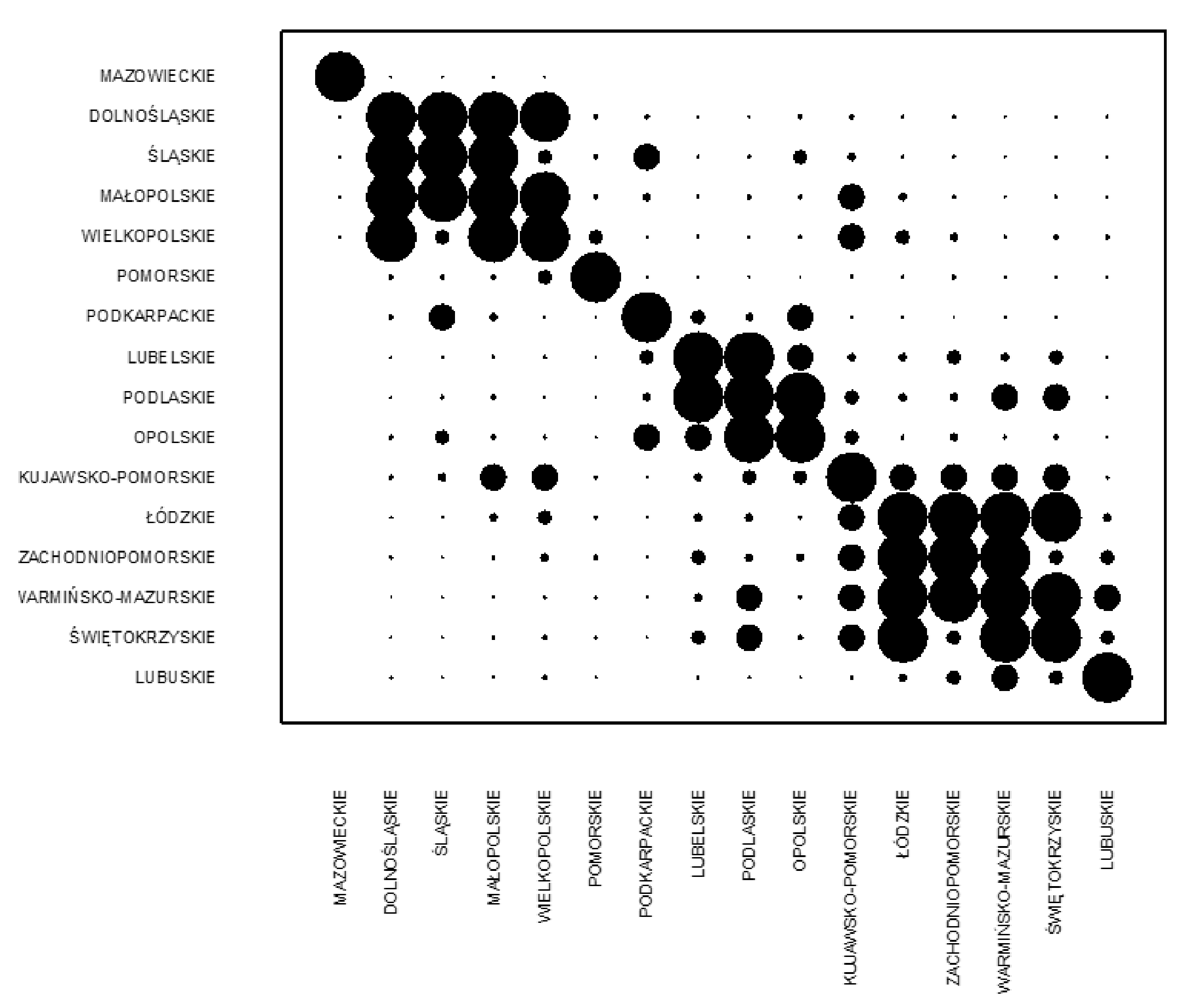
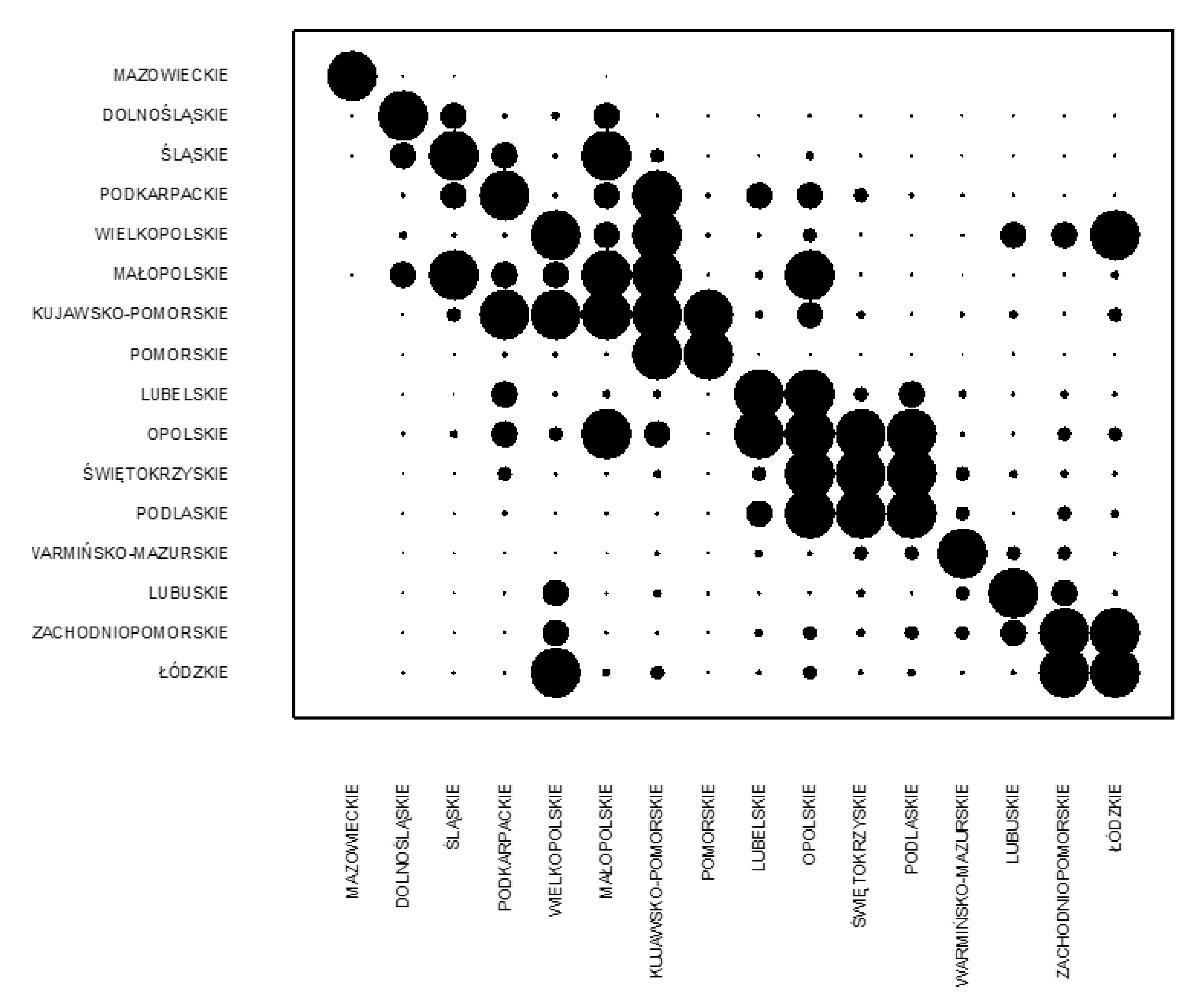
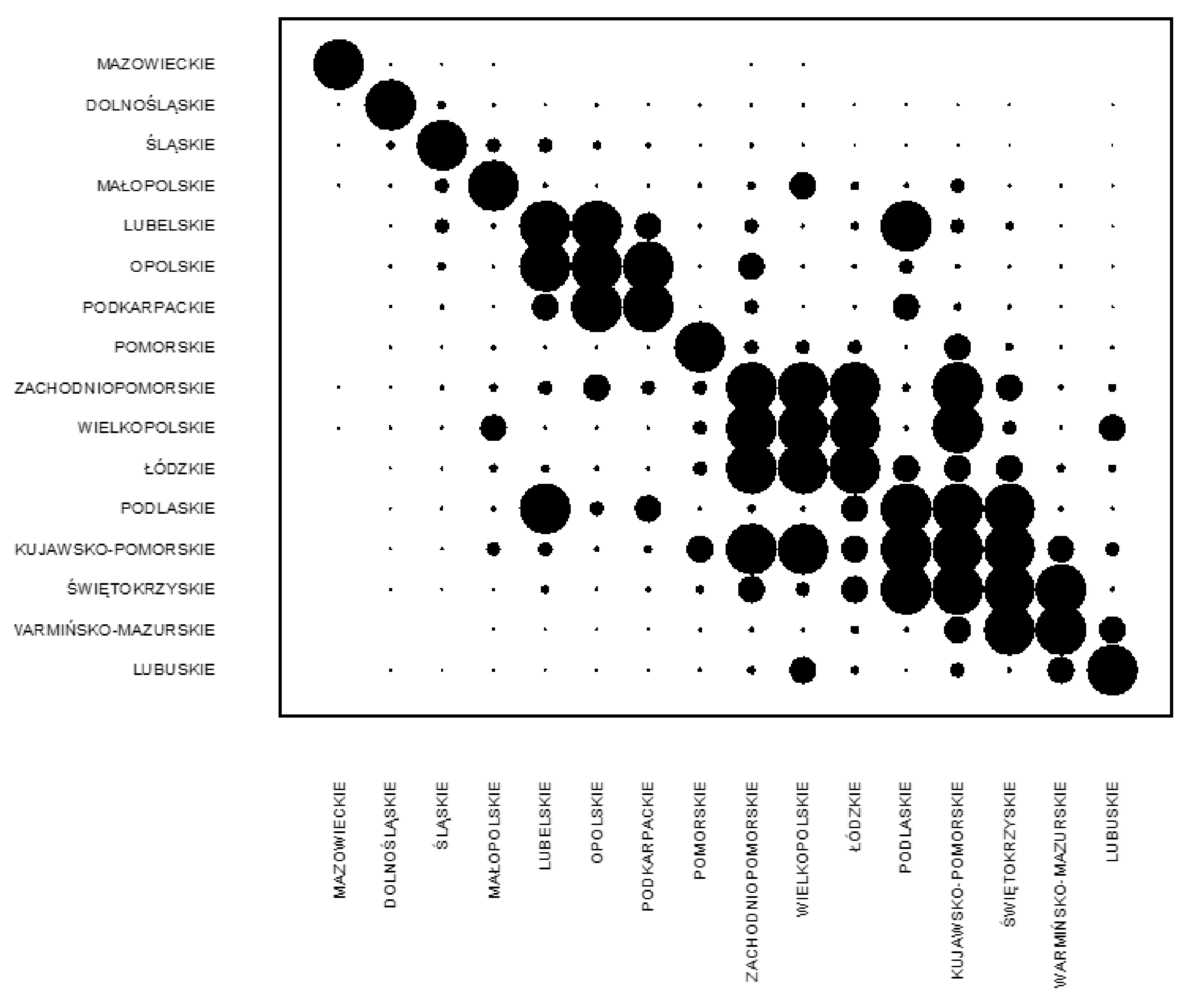
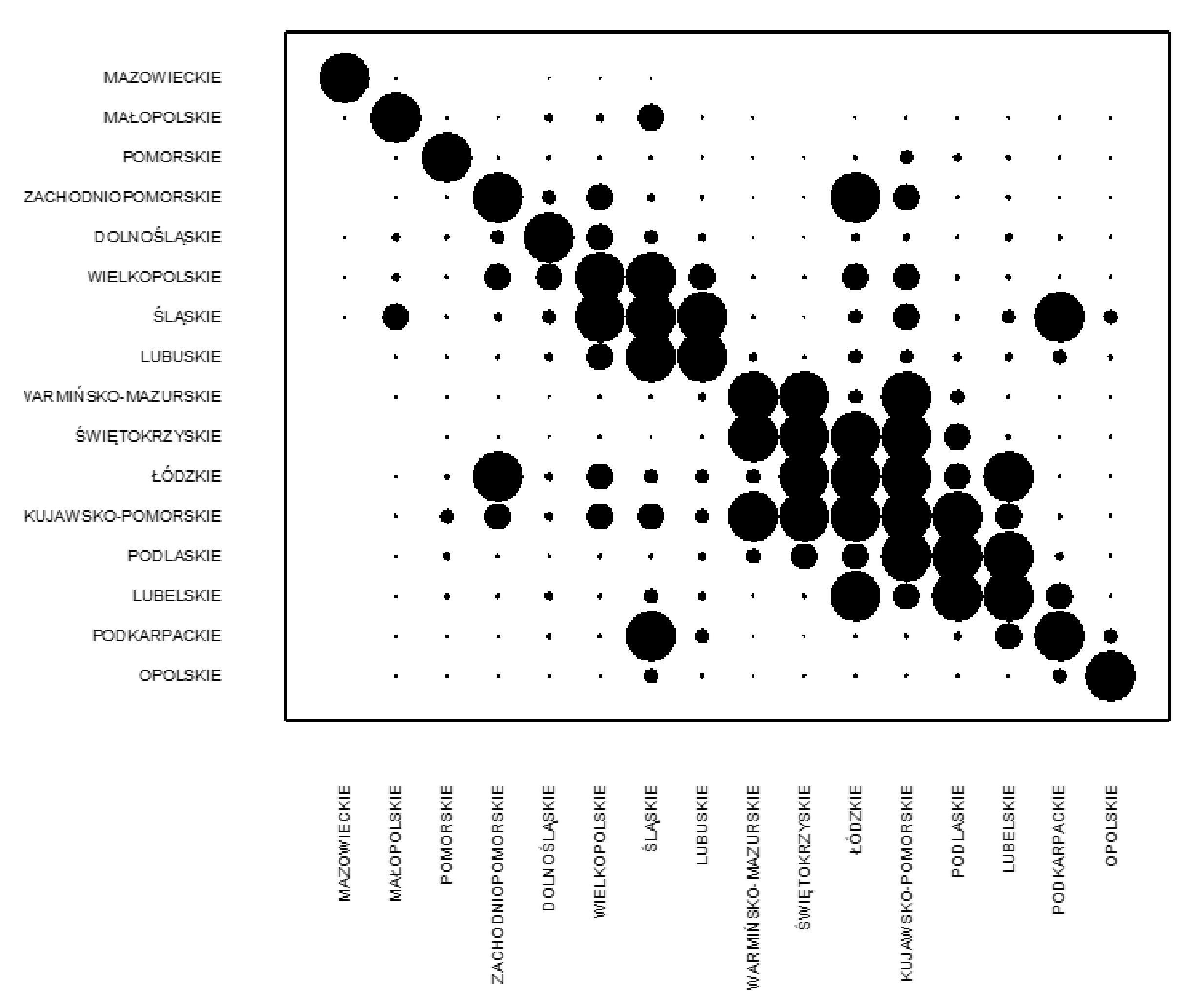
5. Discussion
6. Conclusions
Author Contributions
Funding
Institutional Review Board Statement
Informed Consent Statement
Conflicts of Interest
Appendix A
| Area | Sub | S/D | Variable | Name | Unit | Source |
|---|---|---|---|---|---|---|
| Childhood | D | X1001 | Infant mortality rate | % | Eurostat | |
| S | X1002 | Life expectancy at birth | year | Eurostat | ||
| S | X1003 | Number of midwives per 10,000 inhabitants | person | LDB | ||
| S | X1004 | Fertility rate | % | LDB | ||
| S | X1005 | Children in nursery | % | LDB | ||
| S | X1006 | Children in pre-school education establishments per 1 thousand children aged 3–5 | person | LDB | ||
| S | X1007 | Average monthly disposable income per person | PLN | LDB | ||
| Schooling time/education | S | X2001 | Gross enrolment ratio—primary schools | % | LDB | |
| S | X2002 | Gross enrolment ratio—lower secondary schools | % | LDB | ||
| S | X2003 | Gross enrolment ratio—general secondary schools | % | LDB | ||
| S | X2004 | Gross enrolment ratio—vocational schools | % | LDB | ||
| S | X2005 | Gross enrolment ratio—technical secondary schools | % | LDB | ||
| S | X2006 | Gross enrollment ratio in higher education | % | LDB | ||
| S | X2007 | Mean years of schooling | year | UNDP | ||
| D | X2008 | Early leavers from education and training | % | Eurostat | ||
| S | X2009 | Students per 10,000 inhabitants | person | LDB | ||
| S | X2010 | Percentage of students majoring in technical and natural sciences | % | LDB | ||
| S | X2011 | Graduates per 10,000 population | person | LDB | ||
| S | X2012 | Postgraduate students per 10 thousand inhabitants | person | LDB | ||
| S | X2013 | Doctoral students per 10 thousand inhabitants | person | LDB | ||
| S | X2014 | Number of academic teachers per 10 thousand inhabitants | person | LDB | ||
| S | X2015 | Number of academic teachers with professorial title per 10 thousand inhabitants | person | LDB | ||
| D | X2016 | Number of students per academic teacher | person | LDB | ||
| D | X2017 | Number of pupils per section in primary schools | person | LDB | ||
| D | X2018 | Number of pupils per section in lower secondary schools | person | LDB | ||
| D | X2019 | Number of pupils per section in general secondary schools | person | LDB | ||
| D | X2020 | Number of pupils per teacher in primary school | person | LDB | ||
| D | X2021 | Number of pupils per teacher in lower secondary schools | person | LDB | ||
| D | X2022 | Number of pupils per teacher in general secondary schools | person | LDB | ||
| D | X2023 | Number of pupils per teacher in technical secondary schools | person | LDB | ||
| D | X2024 | Number of pupils per teacher in vocational schools | person | LDB | ||
| S | X2025 | Percentage of students additionally learning a foreign language in primary schools | % | LDB | ||
| S | X2026 | Percentage of students additionally learning a foreign language in lower secondary schoolsStudents following additional foreign language instruction | % | LDB | ||
| S | X2027 | Gymnasium exams—the average performance of students (in the mathematics and natural sciences part) | % | LDB/ OKE | ||
| S | X2028 | Gymnasium exams—the average performance of students (in the humanities part) | % | LDB/ OKE | ||
| S | X2029 | Passing the exam maturity examination in relation to the national average | % | LDB | ||
| S | X2030 | Average monthly per capita household expenditure on education | PLN | LDB | ||
| S | X2031 | Expenditure on education as a proportion of total household expenditure | % | LDB | ||
| S | X2032 | Expenditures of territorial self-government units on education per student | PLN | LDB/ CIO | ||
| S | X2033 | Expenditure on higher education per student | PLN | GUS | ||
| Adulthood | Education | D | X3101 | Percentage of people participating in lifelong learning aged 25–64 | % | Euro |
| S | X3102 | Percentage of people aged 25–64 with primary education | % | Eurostat | ||
| S | X3103 | Percentage of people aged 25–64 with secondary education | % | Eurostat | ||
| S | X3104 | Percentage of people aged 25–64 with tertiary education | % | Eurostat | ||
| Demographic potential | S | X3201 | Population density | person/km2 | LDB | |
| S | X3202 | The net change in population, adjusted for migration | person | LDB | ||
| S | X3203 | The working-age population to the total population | % | LDB | ||
| D | X3204 | Demographic dependency ratio for the population in post-working age | % | LDB | ||
| D | X3205 | The median age of the population | year | Eurostat | ||
| Job | D | X3301 | Percentage of registered unemployed with tertiary education | % | LDB | |
| D | X3302 | Percentage of unemployed with post-secondary and secondary technical education | % | LDB | ||
| D | X3303 | Percentage of unemployed registered with general secondary education | % | LDB | ||
| D | X3304 | Percentage of unemployed with vocational education | LDB | |||
| D | X3305 | Percentage of unemployed with primary education | LDB | |||
| D | X3306 | Share of the long-term unemployed in the total population of the unemployed | % | Eurostat | ||
| D | X3307 | Youth unemployment rate (population aged 15–24) | % | Eurostat | ||
| D | X3308 | Economically inactive per 10 thousand economically active | % | GUS | ||
| D | X3309 | Percentage of job vacancies | % | GUS | ||
| D | X3310 | Percentage of people not in work or education aged 15–24 | % | Eurostat | ||
| D | X3311 | Duration of job search | month | LDB | ||
| S | X3312 | Young people neither in employment nor in education and training | % | Eurostat | ||
| S | X3313 | The employment rate for people with primary education | % | Eurostat | ||
| S | X3314 | The employment rate of people with secondary education | % | Eurostat | ||
| S | X3315 | The employment rate for people with tertiary education | % | Eurostat | ||
| S | X3316 | Employment rates by age 15–24 | % | Eurostat | ||
| S | X1317 | Employment rates by age 25–34 | % | Eurostat | ||
| S | X1318 | Employment rates by age 35–44 | % | Eurostat | ||
| S | X1319 | Employment rates by age 45–54 | % | Eurostat | ||
| S | X1320 | Employment rates by age 55–64 | % | Eurostat | ||
| S | X3321 | Economic activity rates by primary education | % | Eurostat | ||
| S | X3322 | Economic activity rates by secondary education | % | Eurostat | ||
| S | X3323 | Economic activity rates by tertiary education | % | Eurostat | ||
| S | X3324 | The employment rate of disabled people aged 16–64 | % | LDB | ||
| S | X3325 | Average number of usual weekly hours of work in the main job by age 15–24 | hour | Eurostat | ||
| S | X3326 | Average number of usual weekly hours of work in the main job by age 25–64 | hour | Eurostat | ||
| S | X3327 | Average number of usual weekly hours of work in the main job by age 65–74 | hour | Eurostat | ||
| S | X3328 | Gross value added per employee | PLN | LDB | ||
| S | X3329 | Average gross salary of persons with higher education (M.A. and higher) | % | GUS | ||
| S | X3330 | Average gross salary of persons with higher bachelor’s and engineer’s degrees in comparison to the national average | % | GUS | ||
| S | X3331 | Average gross salary of persons with post-secondary education in comparison to the national average | % | GUS | ||
| S | X3332 | Average gross salary of persons with technical education in comparison to the national average | % | GUS | ||
| S | X3333 | Average gross salary of persons with general secondary education in comparison to the national average | % | GUS | ||
| S | X3334 | Average gross salary of persons with general vocational education in comparison to the national average | % | GUS | ||
| S | X3335 | Average gross salary of persons with lower secondary education in comparison to the national average | % | GUS | ||
| S | X3336 | Average gross salary of persons with primary and incomplete primary education in comparison to the national average | % | GUS | ||
| R&D and KBE | S | X3401 | Expenditures on innovation activity in enterprises per economically active person | PLN | LDB | |
| S | X3402 | R&D expenditure per capita | PLN | LDB | ||
| S | X3403 | Employment in technology and knowledge-intensive sectors to the total number of employees | % | Eurostat | ||
| S | X3404 | Human resources in science and technology (HRST) as % of the active population | % | Eurostat | ||
| S | X3405 | Employment in high-tech sectors as % of the active population | % | Eurostat | ||
| Entrepreneurship | S | X3501 | Entities entered in the REGON register per 10 thousand population | object | LDB | |
| S | X3502 | Natural persons conducting economic activity per 100 persons of working age | person | LDB | ||
| S | X3503 | Number of business environment institutions per 100 thousand inhabitants | IOB | |||
| S | X3504 | Funds from E.U. to finance programs and projects E.U. per capita | PLN | LDB | ||
| S | X3505 | Households furnished with a personal computer and a broadband connection to the Internet | % | LDB | ||
| Social capital | S | X3601 | Voter turnout in parliamentary elections | % | LDB | |
| S | X3602 | Foundations, associations, and social organizations per 10,000 population | object | LDB | ||
| Leisure | S | X3701 | Library loans per borrower in volumes | book | LDB | |
| D | X3702 | Number of population per one seat in fixed cinemas | person | LDB | ||
| S | X3703 | Museum/branch visitors per 10,000 population | person | LDB | ||
| S | X3704 | Sports clubs including religious and UKS clubs per 10,000 inhabitants | object | LDB | ||
| Social exclusion | D | X3801 | Social assistance benefits—beneficiaries per 10,000 population | PLN/person | LDB | |
| D | X3802 | Poverty rates—in % of persons in households with expenditures below the extreme poverty threshold | % | LDB | ||
| Health | S | X3901 | Nurses and midwives per 10 thous. population | person | LDB | |
| S | X3902 | Doctors per 10 thous. population | person | LDB | ||
| S | X3903 | Beds in general hospitals per 10 thous. population | object | LDB | ||
| D | X3904 | Deaths of people due to cardiovascular disease per 100 thous. population | person | LDB | ||
| D | X3905 | Deaths due to cancer per 100 thous. population | person | LDB | ||
| D | X3906 | Deaths of people due to mental and behavioral disorders per 10 thous. population | person | LDB | ||
| D | X3907 | Suicide per 10 thous. population | person | LDB | ||
| D | X3908 | Occupational diseases per 10 thous. economically active persons | person | LDB | ||
| S | X3909 | Average monthly gross pension due to an inability to work | PLN | LDB | ||
| S | X3910 | Private households—average monthly expenditures on health per capita | PLN | LDB | ||
| S | X3911 | Local government expenditures on health care per capita | LDB | |||
| Postproductiveage | S | X4001 | Average monthly gross retirement from a non-agricultural social security system | PLN | LDB | |
| S | X4002 | Average monthly gross retirement for farmers | PLN | LDB | ||
| S | X4003 | Economic activity rates after 65 years old | % | Eurostat | ||
| S | X4004 | Residents of social welfare home per 10 thous. inhabitants | person | LDB |
| Area | Variable | Name | Unit | Source |
|---|---|---|---|---|
| Innovativeness of enterprises | Y101 | The average share of innovative enterprises in the total number of enterprises | % | LDB |
| Y102 | Innovative service sectors enterprises by new or improved products | % | LDB | |
| Y103 | Innovative service sectors enterprises by new or improved products to the market | % | LDB | |
| Y104 | Innovative service sectors enterprises by new or improved business processes | % | LDB | |
| Y105 | Innovative industrial enterprises by new or improved products | % | LDB | |
| Y106 | Innovative industrial enterprises by new or improved products to the market | % | LDB | |
| Y107 | Industrial enterprises by new or improved business processes | % | LDB | |
| Y108 | Innovative industrial enterprises that cooperated in terms of innovation activity in % of total enterprises | % | LDB | |
| Y109 | Innovative enterprises in the service sector that cooperated in terms of innovation activity in % of total enterprises | % | LDB | |
| Y110 | Industrial enterprises that participated in innovation activities cluster or other formal types of cooperation in % of the innovation active enterprises | % | LDB | |
| Sales/export of innovative products | Y201 | Share of net revenues from sales of exported innovative products to the market in total net revenues from sales (industrial enterprises) | % | LDB |
| Y202 | Share of net revenues from sales of exported innovative products in total net revenues from sales (industrial enterprises) | % | LDB | |
| Y203 | Share of net revenues from sales of innovative to the market products in total net revenues from sales (industrial enterprises) | % | LDB | |
| Y204 | Share of sold production of new or significantly improved industry goods in industrial enterprises in the total amount of sold goods | % | LDB | |
| Y205 | Share of net income from the sale of products in entities classified to high and medium- | % | LDB | |
| FDI foreign direct investment | Y301 | New entities of the national economy recorded per 10,000 of population at working age | object | LDB |
| Y302 | Investment outlays in the companies with foreign capital to total investment outlays | % | LDB | |
| Y303 | Foreign capital per inhabitant of working age | PLN | LDB | |
| Y304 | Number of units with foreign capital per 100 thousand inhabitants | unit | LDB | |
| Y305 | Number of employees in companies with foreign capital participation per 1 thousand total employees | unit | LDB | |
| inventiveness | Y401 | Patents granted by the Patent Office of the Republic of Poland (PORP) per 100 thous. population | unit | PORP |
| Y402 | Rights of protection granted by the Patent Office of the Republic of Poland per 100 thous. population | unit | PORP | |
| Y403 | Patent applications filed in the Patent Office of the Republic of Poland per 100 thous. population | unit | PORP | |
| Y404 | Rights of protection filed in the Patent Office of the Republic of Poland per 100 thous. population | unit | PORP | |
| Y405 | Patents-applications filed with EPO (Patstat) per 100 thous. inhabitants | unit | Patstat | |
| Potential of science | Y501 | Scientific publications per 1 million inhabitants with at least one foreign author in English | unit | RIS |
| Y502 | Number of scientific publications with the highest citations (10% of the most citations worldwide) to the total number of publications in the region as a relation to the E.U. average | unit | RIS | |
| Economic Growth | Y601 | Gross domestic product per capita | PLN | LDB |
References
- Gennaioli, N.; la Porta, R.; Lopez-de-Silanes, F.; Shleifer, A. Human capital and economic development. Q. J. Econ. 2013, 128, 105–164. [Google Scholar] [CrossRef] [Green Version]
- Mincer, J. Human capital and economic growth. Econ. Educ. Rev. 1984, 3, 195–205. [Google Scholar] [CrossRef] [Green Version]
- Schultz, T.W. Investment in human capital. Am. Econ. Rev. 1961, 51, 1–17. [Google Scholar]
- Becker, G.S. Human Capital: A Theoretical and Empirical Analysis, with Special Reference to Education; The University of Chicago Press: Chicago, IL, USA, 1994. [Google Scholar]
- Domański, S.R. Kapitał Ludzki a Wzrost Gospodarczy; Wydawnictwo Naukowe PWN: Warszawa, Poland, 1993. [Google Scholar]
- Healy, S.; Côté, S. The Well-Being of Nations: The Role of Human and Social Capital. Education and Skills; OECD: Paris, France, 2001. [Google Scholar]
- Hause, J.C. Earnings Profile: Ability and Schooling. J. Polit. Econ. 1972, 80, S108–S138. [Google Scholar] [CrossRef]
- Taubman, T.J.; Wales, P.J. Higher education, mental ability, and screening. J. Polit. Econ. 1973, 81, 28–55. [Google Scholar] [CrossRef]
- McDonald, J.; Roberts, S. Growth and multiple forms of human capital in an augmented Solow model: A panel data investigation. Econ. Lett. 2002, 74, 271–276. [Google Scholar] [CrossRef]
- Luthans, F.; Luthans, K.W.; Luthans, B.C. Positive psychological capital: Beyond human and social capital. Bus. Horiz. 2004, 47, 45–50. [Google Scholar] [CrossRef] [Green Version]
- Laroche, G.C.; Mérette, M.; Ruggeri, M. On the concept and dimensions of human capital in a knowledge-based economy context. Can. Public Policy 1999, 25, 87–100. [Google Scholar] [CrossRef]
- Tamura, J. Income convergence in an endogeneous growth model. J. Polit. Econ. 1991, 99, 522–540. [Google Scholar] [CrossRef]
- Lucas, R.E. On the mechanics of economic development. J. Monet. Econ. 1988, 22, 3–42. [Google Scholar] [CrossRef]
- Benabou, R. Heterogeneity, stratification, and growth: Macroeconomic implications of community structure and school finance. Am. Econ. Rev. 1996, 86, 584–609. [Google Scholar]
- Liu, B.M.; Fraumeni, G. Measuring Human Capital Measurement: Country Experiences and International Initiatives; Cambridge University Press: Cambridge, UK, 2016. [Google Scholar]
- Korenik, S. Region Ekonomiczny w Nowych Realiach Społeczno-Gospodarczych; CeDeWu: Warszawa, Poland, 2011. [Google Scholar]
- OECD/Eurostat. Oslo Manual 2018. Guidelines for collecting, reporting and using data on innovation. In The Measurement of Scientific, Technological and Innovation Activities, 4th ed.; OECD Publishing: Paris/Eurostat, Luxembourg, 2018; Available online: https://www.oecd-ilibrary.org/science-and-technology/the-measurement-of-scientific-technological-and-innovation-activities_24132764 (accessed on 18 September 2021).
- Reichel, M. Innowacyjność i konkurencyjność regionów. Kwestie definicyjne—Zakres zbieżności. In Rozwój Regionalny w Polsce w Świetle Wyzwań XXI Wieku; Kudłacz, T., Ed.; Komitet Przetrzennego Zagospodarowania PAN: Warsaw, Poland, 2010; p. 40. [Google Scholar]
- Leydesdorff, L. Synergy in knowledge-based innovation systems at national and regional levels: The Triple-Helix model and the Fourth industrial revolution. J. Open Innov. Technol. Mark. Complex. 2018, 4, 16. [Google Scholar] [CrossRef] [Green Version]
- Gault, F. Defining and measuring innovation in all sectors of the economy. Res. Policy 2018, 47, 617–622. [Google Scholar] [CrossRef]
- Better Policies for 2030 An OECD Action Plan on the Sustainable Development Goals; OECD: Paris, France, 2016; Available online: https://www.oecd.org/dac/OECD-action-plan-on-the-sustainable-development-goals-2016.pdf (accessed on 18 September 2021).
- Fagerberg, J. Mobilizing innovation for sustainability transitions: A comment on transformative innovation policy. Res. Policy 2018, 47, 1568–1576. [Google Scholar] [CrossRef]
- Danquah, M.; Amankwah-Amoah, J. Assessing the relationships between human capital, innovation and technology adoption: Evidence from sub-Saharan Africa. Technol. Forecast. Soc. Chang. 2017, 122, 24–33. [Google Scholar] [CrossRef]
- George, G.; McGahan, A.M.; Prabhu, J. Innovation for inclusive growth: Towards a theoretical framework and a research agenda. J. Manag. Stud. 2012, 49, 661–683. [Google Scholar] [CrossRef]
- Romer, P.M. Endogenous technological change. J. Polit. Econ. 1990, 98, 71–102. [Google Scholar] [CrossRef] [Green Version]
- Grossman, G.M.; Helpman, E. Trade, innovation, and growth. Am. Econ. Rev. 1990, 80, 86–91. [Google Scholar]
- Aghion, P.; Howitt, P.; Howitt, P.W.; Brant-Collett, M.; García-Peñalosa, C. Endogenous Growth Theory; MIT Press: Cambridge, MA, USA, 1998. [Google Scholar]
- Lenihan, H.; McGuirk, H.; Murphy, K.R. Driving innovation: Public policy and human capital. Res. Policy 2019, 48, 103791. [Google Scholar] [CrossRef]
- Gorzelak, B.; Jałowiecki, G. Konkurencyjność regionów. Studia Reg. i Lokalne 2000, 1, 7–24. [Google Scholar]
- Herbst, M. Kapitał ludzki, dochód i wzrost gospodarczy w badaniach empirycznych. In Kapitał Ludzki i Kapitał Społeczny a Rozwój Regionalny; Herbst, M., Ed.; Wydawnictwo Scholar: Warszawa, Poland, 2007; pp. 118–123. [Google Scholar]
- Jagódka, M. Kapitał ludzki jako determinanta innowacyjności i konkurencyjności miast w regionie Małopolski. In Funkcje Średnich Ośrodków Miejskich Jako Regionalnych Biegunówrozwoju Społeczno-Ekonomicznego; Prusek, A., Ed.; WSGiZ Kraków: Kraków, Poland, 2017; pp. 53–87. [Google Scholar]
- di Liberto, A. Education and Italian regional development. Econ. Educ. Rev. 2008, 27, 94–107. [Google Scholar] [CrossRef] [Green Version]
- Badinger, G.; Tondl, H. TradHuman Capital and Innovation: The Engines of European Regional Growth in the 1990s. In European Regional Growth; Fingleton, B., Ed.; Springer: Berlin/Heidelberg, Germany, 2003; pp. 215–239. [Google Scholar]
- Engelbrecht, H.J. Human capital and international knowledge spillovers in TFP growth of a sample of developing countries: An exploration of alternative approaches. Appl. Econ. 2002, 37, 831–841. [Google Scholar] [CrossRef]
- Sterlacchini, A. R&D, higher education and regional growth: Uneven linkages among European regions. Res. Policy 2008, 37, 1096–1107. [Google Scholar]
- Cuaresma, J.C.; Doppelhofer, G.; Feldkircher, M. The determinants of economic growth in European regions. Reg. Stud. 2014, 48, 44–67. [Google Scholar] [CrossRef]
- Florida, F. The flight of the creative class: The new global competition for talent. Lib. Educ. 2006, 92, 22–29. [Google Scholar]
- Laskowska, B.; Dańska-Borsiak, I. The importance of human capital for the economic development of EU regions. Comp. Econ. Res. 2016, 19, 63–79. [Google Scholar] [CrossRef] [Green Version]
- Fagerberg, J.; Verspagen, B.; Caniëls, M. Technology, Growth and Unemployment across European Regions Technology, Growth and Unemployment across European Regions. Reg. Stud. 1997, 31, 457–466. [Google Scholar] [CrossRef]
- Azorín, J.D.B.; de la Vega, M.D.M.S. Human capital effects on labour productivity in EU regions. Appl. Econ. 2015, 47, 4814–4828. [Google Scholar] [CrossRef]
- Golejewska, A. Human capital and regional growth perspective. Barom. Reg. 2013, 11, 7–17. [Google Scholar]
- Hirschman, A.O. Strategy of Economic Development; Yale University Press: New Haven, CT, USA, 1958. [Google Scholar]
- Myrdal, G. Economic Theory and Underdeveloped Regions; Gerald Duckworth: London, UK, 1957. [Google Scholar]
- Iammarino, S.; Rodriguez-Pose, A.; Storper, M. Regional inequality in Europe: Evidence, theory and policy implications. J. Econ. Geogr. 2019, 19, 273–298. [Google Scholar] [CrossRef]
- Friedmann, J. A General Theory of Polarized Development; The Free Press: New York, NY, USA, 1972. [Google Scholar]
- Perroux, F. Economic space: Theory and applications. Q. J. Econ. 1950, 64, 89–104. [Google Scholar] [CrossRef]
- Łukasiewicz, G.; Organizacji, K.L. Pomiar i Sprawozdawczość; PWN: Warszawa, Poland, 2009. [Google Scholar]
- Le, L.; Gibson, T.; Oxley, J. Cost-and income-based measures of human capital. J. Econ. Surv. 2003, 17, 271–307. [Google Scholar] [CrossRef]
- Czekanowski, J. Zur Differentialdiagnose der Neandertalgruppe. Korespondentblatt der Deutschen Gesellschaft fur Anthropologie. Ethnol. Urgesch 1909, 40, 44–47. [Google Scholar]
- Arabie, L.; Hubert, P. Overview of Combinatorial Data Analysis. In Clustering and Classification; Arabie, G., Hubert, P., Soete, L., Eds.; World Scientifistic: River Edge, NJ, USA, 1996; pp. 5–63. [Google Scholar]
- Hubert, J.; Arabie, L.; Meulman, P. Combinatorial Data Analysis: Optimization by Dynamic Programming; Society for Industrial and Applied Mathematics (SIAM): Philadelphia, PA, USA, 2001. [Google Scholar]
- Brusco, S.; Stahl, M.J. Branch-and-Bound Applications in Combinatorial Data Analysis; Springer Science & Business Media: New York, NY, USA, 2006. [Google Scholar]
- Petrie, F. Sequences in Prehistoric Remains. J. Anthropol. Inst. Great Br. Irel. 1899. Available online: https://www.semanticscholar.org/paper/Sequences-in-Prehistoric-Remains-Petrie/35f89e9f654e79f32a7a1362d998a8f11e383cd0 (accessed on 18 September 2021). [CrossRef]
- Hahsler, C.; Hornik, M. Buchta Getting things in order: An introduction to the R package seriation. J. Stat. Softw. 2008, 25, 1–34. [Google Scholar] [CrossRef] [Green Version]
- Kendall, D. Abundance matrices and seriation in archaeology. Z. Wahrscheinlichkeitstheorie Verwandte Geb. 1971, 17, 104–112. [Google Scholar] [CrossRef]
- Robinson, W.S. A Method for Chronologically Ordering Archaeological Deposits. Am. Antiq. 1951, 16, 293–301. [Google Scholar] [CrossRef]
- Hubert, L. Some Applications of Graph Theory and Related Nonmetric Techniques to Problems of Approximate Seriation: The Case of Symmetric Proximity Measures. Br. J. Math. Stat. Psychol. 1974, 27, 133–153. [Google Scholar] [CrossRef]
- Caraux, S.; Pinloche, G. Permutmatrix: A Graphical Environment to Arrange Gene Expression Profiles in Optimal Linear Order. Bioinformatics 2005, 21, 1280–1281. [Google Scholar] [CrossRef] [Green Version]
- Bar-Joseph, T.S.; Gifford, Z.; Jaakkola, D.K. Fast Optimal Leaf Ordering for Hierarchical Clustering. Bioinformatics 2001, 17, 22–29. [Google Scholar] [CrossRef] [Green Version]
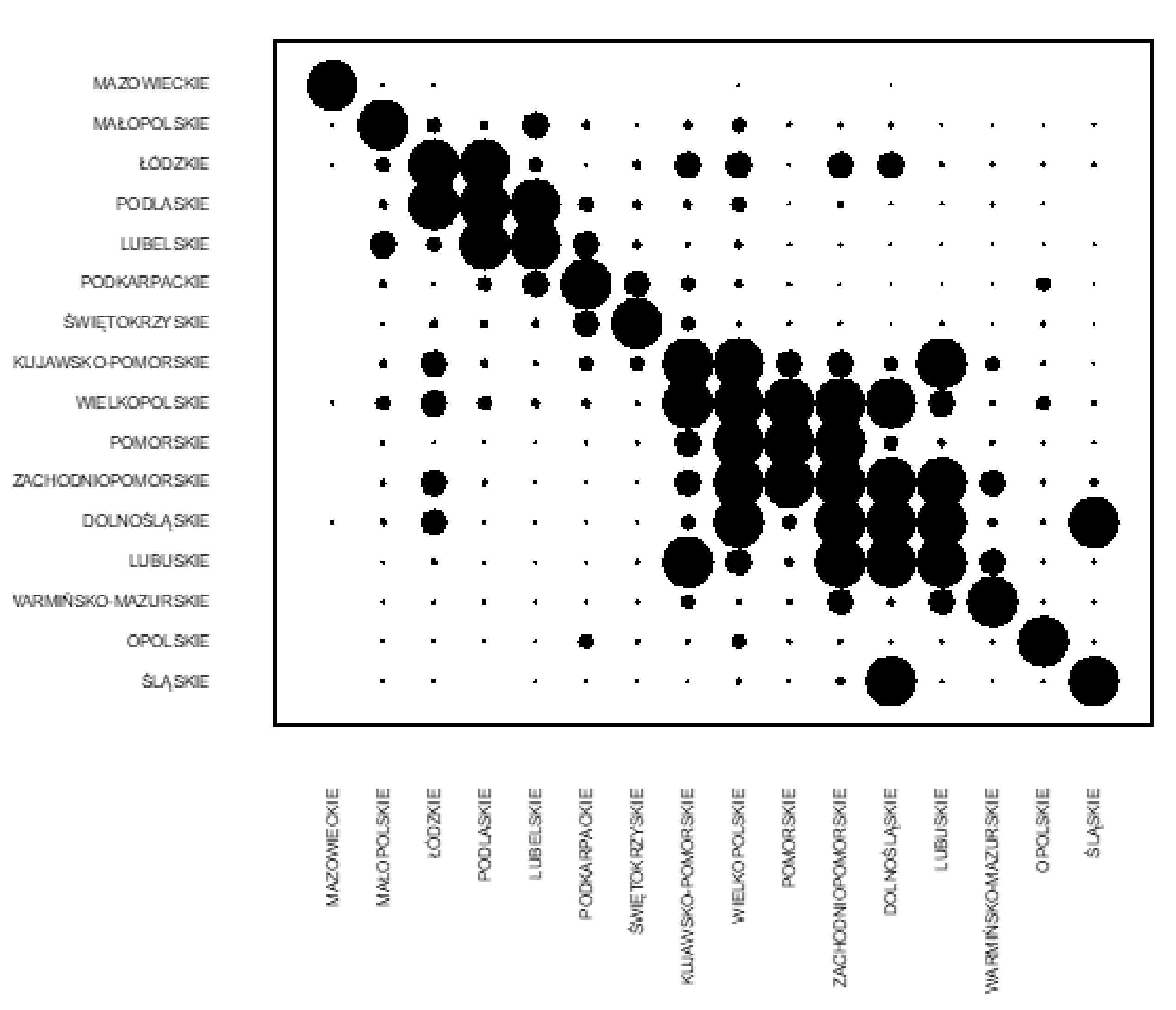
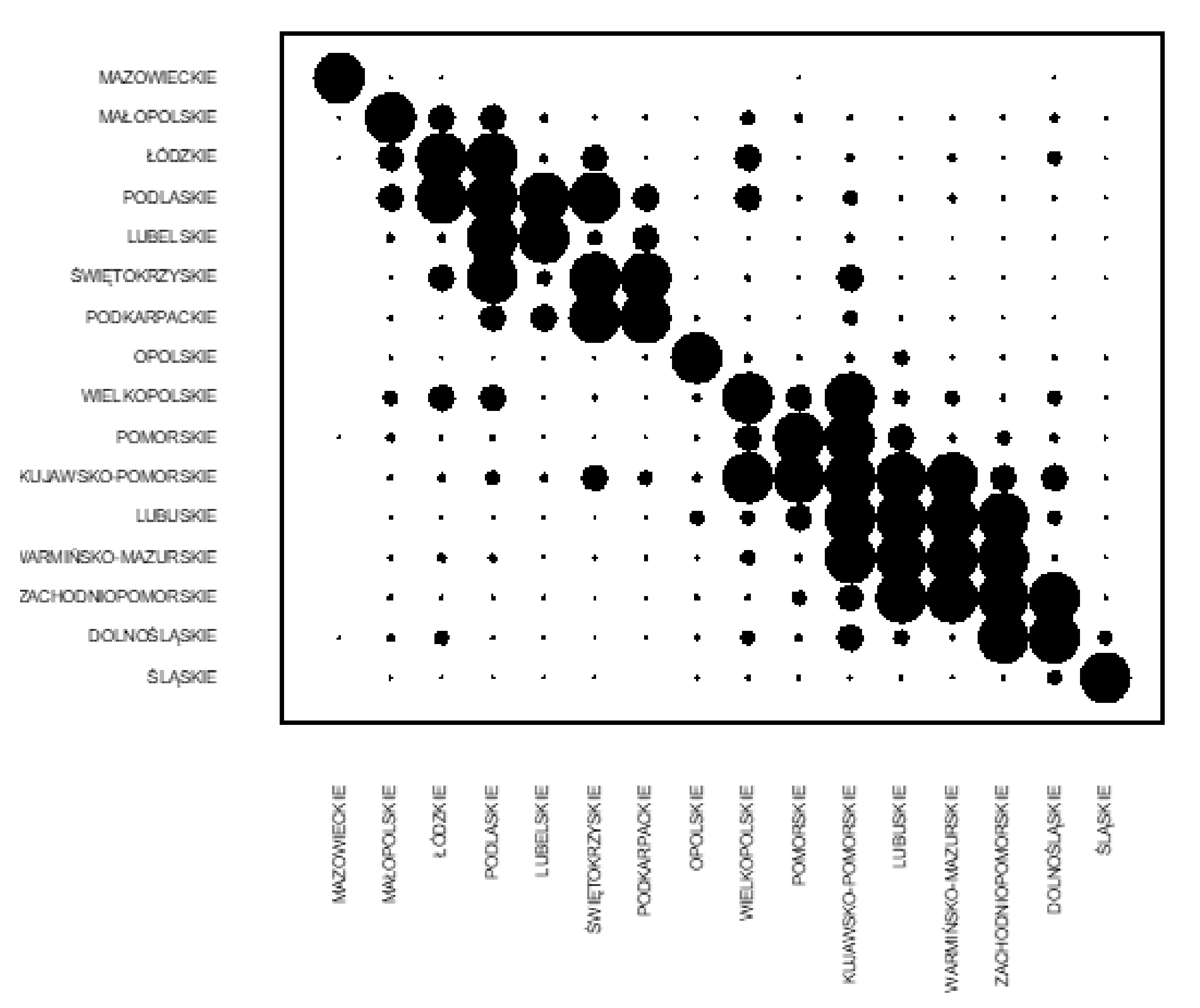
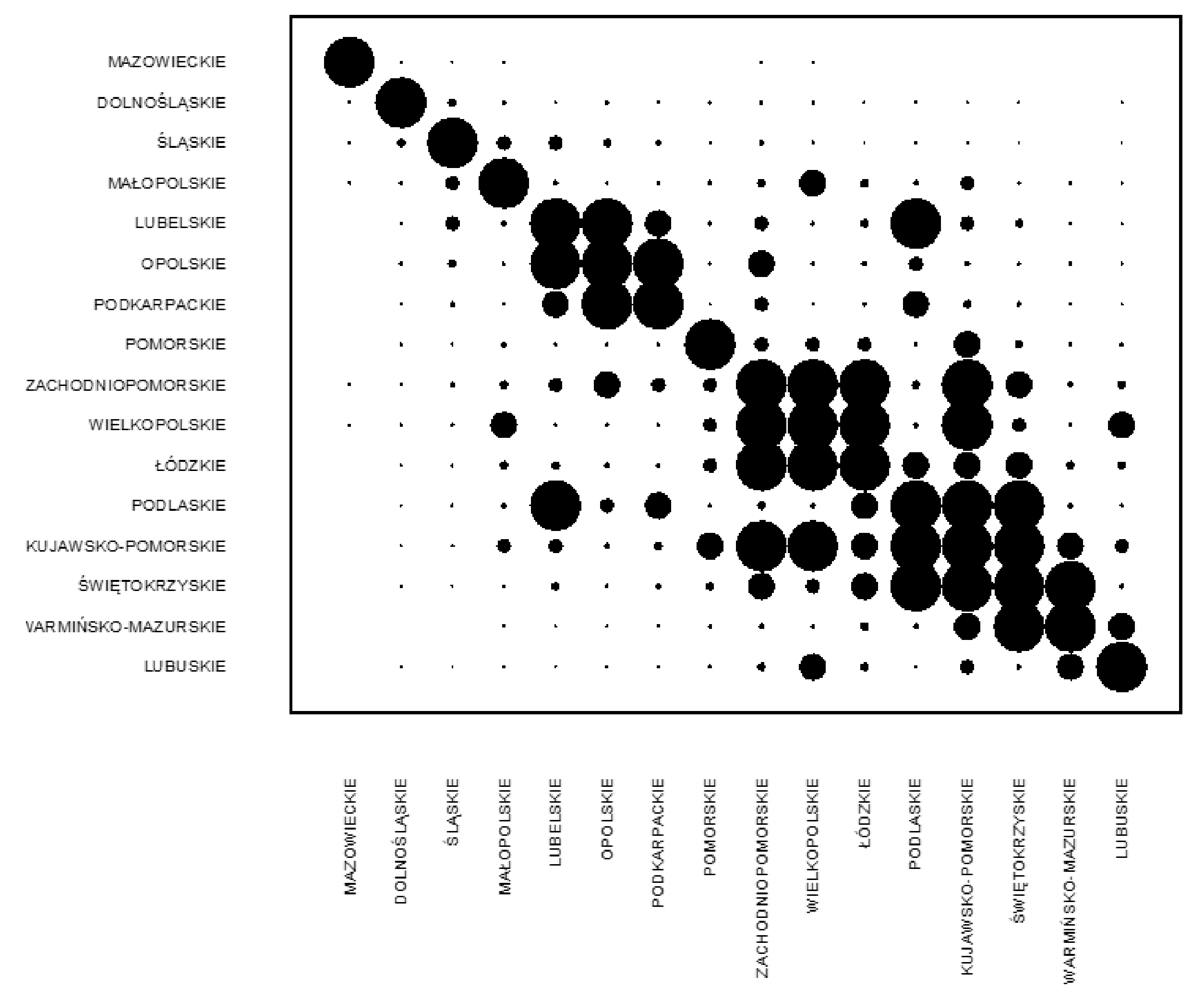
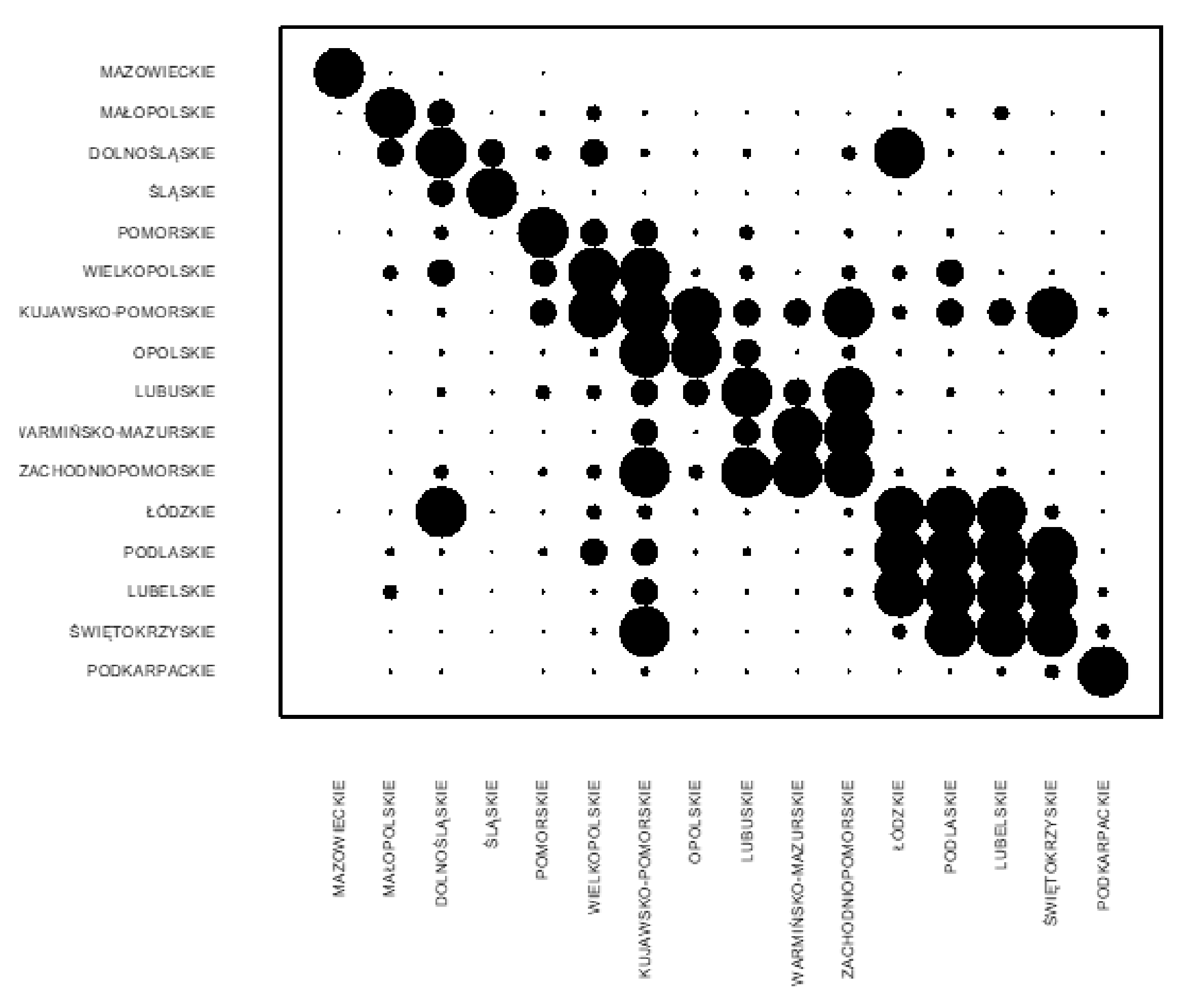
| Analysis Criterion | Human Capital | Physical Capital |
|---|---|---|
| Form | It is embodied in man. It cannot be subject to market exchange. | It takes a tangible form that can be traded on the market at any time. |
| Measurability | Measurement is challenging due to intangible aspects of human capital. | Market value in monetary units is relatively easy to estimate. |
| Funding | It is limited, primarily subsidized in the form of academic/social scholarships. | Relatively easy, which is due to a large number of market transactions for this manufacturing factor. |
| Significance for development | In the digital age, it is growing | Prominent in the era of industrialization. It is decreasing under GOW conditions. |
| Marginal productivity | It grows as it is used, which is related to gaining experience. | It decreases with use. |
| Accumulation | It is more time and labor-intensive because of the social aspect of human capital. It can take different forms: formal and informal learning. Not always dependent on the capital owner. | It depends on the decisions of the holders (owners) of capital. |
| Treatment | Because it is embodied in a person, it should be treated as a subject. | Objective approach. |
Publisher’s Note: MDPI stays neutral with regard to jurisdictional claims in published maps and institutional affiliations. |
© 2021 by the authors. Licensee MDPI, Basel, Switzerland. This article is an open access article distributed under the terms and conditions of the Creative Commons Attribution (CC BY) license (https://creativecommons.org/licenses/by/4.0/).
Share and Cite
Jagódka, M.; Snarska, M. The State of Human Capital and Innovativeness of Polish Voivodships in 2004–2018. Sustainability 2021, 13, 12620. https://doi.org/10.3390/su132212620
Jagódka M, Snarska M. The State of Human Capital and Innovativeness of Polish Voivodships in 2004–2018. Sustainability. 2021; 13(22):12620. https://doi.org/10.3390/su132212620
Chicago/Turabian StyleJagódka, Maciej, and Małgorzata Snarska. 2021. "The State of Human Capital and Innovativeness of Polish Voivodships in 2004–2018" Sustainability 13, no. 22: 12620. https://doi.org/10.3390/su132212620
APA StyleJagódka, M., & Snarska, M. (2021). The State of Human Capital and Innovativeness of Polish Voivodships in 2004–2018. Sustainability, 13(22), 12620. https://doi.org/10.3390/su132212620







